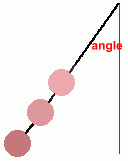
Decide what angle you will use to set the pendulum swinging. Mark it on the wall behind the release point. Set up the full length of string with one weight on the end. Trial 1: Draw the weight back to the marked angle and allow it to swing for five full periods (over and back, 5 times). Time how long it takes to do this. Then divide your answer by five, to get the time for one full period. Repeat this twice more. Don't forget to divide by five each time ... we want the time for one period. Now average your three answers. If you have printed this page, record your answer here: Trial 2: Retie the string at the top so it is about a third shorter. Draw the weight back to the marked angle and allow it to swing for five full periods (over and back, 5 times). Time how long it takes to do this. Then divide your answer by five, to get the time for one full period. Repeat this twice more. Don't forget to divide by five each time ... we want the time for one period. Now average your three answers. If you have printed this page, record your answer here: Trial 3: Retie the string at the top so it is half as long as the previous trial. Draw the weight back to the marked angle and allow it to swing for five full periods (over and back, 5 times). Time how long it takes to do this. Then divide your answer by five, to get the time for one full period. Repeat this twice more. Don't forget to divide by five each time ... we want the time for one period. Now average your three answers. If you have printed this page, record your answer here: By now you should have data that will lead you to a conclusion. You might want to write your conclusion here: The shorter the string, the _____________________ the period. To see the equation that determines the period of a pendulum, visit this page. |
